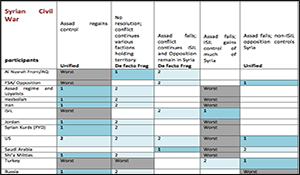Part III: Use Case Analysis of Iraqi-Syrian Conflict

Unpacking the Regional Conflict System surrounding Iraq and Syria—Part III: Implications for the Regional Future: Syria Example of Actor Interests, Resolve and Capabilities Analysis.
Author | Editor: Astorino-Coutois, A. (NSI, Inc).
This is Part III of a larger study exploring the dynamics of the central Middle East conflict system. Part I described the system and why it is critical to assess US security interests and activities holistically rather than just in terms of the conflicts (e.g., defeat of ISIL) in which the US is most interested. Part II described the analytic approach used to assess regional dynamics and regional futures based on the alignments and conflicts among three critical drivers: actor interests, resources and resolves. Part III illustrates the analytic process applied to 20-plus actors for five conflicts. It uses the Syrian Civil War as a use case.
This paper presents the analysis of the Syrian Civil War to illustrate the analytic process that was applied to 20-plus actors over five regional conflicts in and around Syria and Iraq: 1) The Syrian Civil War; 2) the battle to Defeat ISIL in Syria; 3) the battle to Defeat ISIL in Iraq; 4) the Iran-Saudi Regional Rivalry; and, 5) the conflict over domestic control among the Shi’a hardline, Kurds, Abadi Government and Sunni tribal leaders. It looks in detail at the actor interests involved in the Syrian Civil conflict and includes the top-level findings assessment, characterization of the conflict based on the interests at stake, description of the posited outcomes, a summary of the preferences over those outcomes for each participating actor and a discussion of the implication of actor resolve and capabilities.

Comments